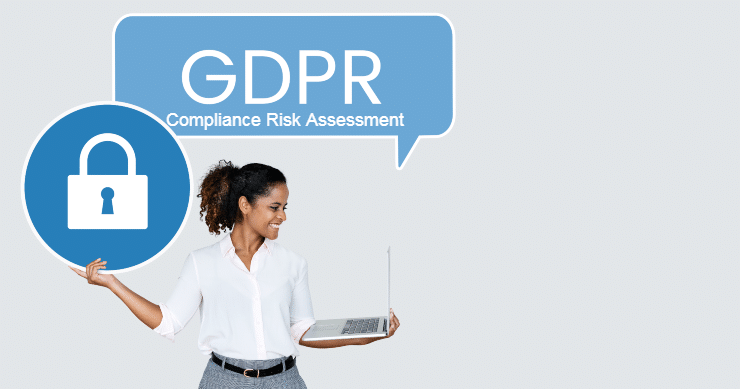Embarking on the GDPR (General Data Protection Regulation) compliance journey inevitably brings us face-to-face with a pivotal requirement: regular risk assessments. But let’s demystify the process—these assessments are not just a regulatory checkbox; they serve as a strategic compass, guiding organizations through the intricacies of data protection and helping them proactively address potential challenges.
While the common perception might be that risks primarily stem from external threats, GDPR sheds light on a broader landscape. It acknowledges that data is susceptible to intentional cyber threats and unintentional events such as accidental loss, destruction, or disclosure. It prompts a thorough examination of vulnerabilities at every step of the data handling process.

Defining GDPR Compliance Risk Assessments
At its core, a GDPR risk assessment is a systematic process aimed at identifying, evaluating, and mitigating the risks associated with processing personal data. GDPR, enacted in 2018, requires organizations to adopt a proactive approach to data protection, emphasizing the need for continuous assessment and improvement.
Start Getting Value With
Centraleyes for Free
See for yourself how the Centraleyes platform exceeds anything an old GRC
system does and eliminates the need for manual processes and spreadsheets
to give you immediate value and run a full risk assessment in less than 30 days
Key Components of GDPR Risk Assessments
1. Data Mapping and Inventory
To effectively manage risks, organizations must clearly understand the personal data they process. Data mapping involves identifying and categorizing the collected, stored, and processed data types. This step lays the foundation for a comprehensive risk assessment.
2. Threat Identification
Both external and internal threats pose risks to data security. Cyberattacks, unauthorized access, and employee errors are just a few examples. Thorough threat identification is essential for crafting robust risk mitigation strategies.
3. Vulnerability Assessment
Identifying weaknesses in systems and processes is critical for preemptively addressing potential points of failure. Regular vulnerability assessments ensure that security measures remain effective against emerging threats.
4. Impact Analysis
Assessing the potential impact of a data breach is crucial for prioritizing risk mitigation efforts. Evaluating financial, reputational, and legal consequences enables organizations to allocate resources strategically.
GDPR Risk Assessments vs. Impact Analysis
In the context of GDPR (General Data Protection Regulation), both terms, “risk assessments” and “impact assessments,” are relevant, but they refer to slightly different concepts.
- Risk Assessments:
- Definition: A risk assessment, in the context of GDPR, involves identifying and evaluating potential risks related to the processing of personal data. It aims to assess the likelihood and impact of various risks on data protection.
- Purpose: The primary purpose of a risk assessment is to proactively manage and mitigate risks associated with the processing of personal data. This includes identifying vulnerabilities, assessing the effectiveness of current safeguards, and implementing measures to minimize potential threats.
- Data Protection Impact Assessments (DPIAs):
- Definition: A Data Protection Impact Assessment (DPIA) is a specific type of assessment required by GDPR in certain situations. It is a systematic process for assessing the impact of data processing activities on individuals’ privacy and data protection rights.
- Purpose: DPIAs are designed to identify and minimize the data protection risks of a project. They are particularly necessary when processing operations are likely to result in high risks to individuals’ rights and freedoms. DPIAs are a key element of the “data protection by design and by default” principle, promoting a proactive approach to privacy.
Conducting a GDPR Compliance Risks: Guide to Assessment
1. Establishing a Framework
Selecting a suitable risk assessment methodology, such as NIST or ISO 27001, forms the foundation of a comprehensive risk assessment framework. Clear risk criteria and thresholds should be defined to guide the assessment process.
2. Data Protection Impact Assessments (DPIA)
DPIAs are a key tool in GDPR risk management, integral to the principle of ‘data protection by design and by default.’ These assessments help organizations identify, record, and minimize data protection risks associated with specific projects. In some cases, DPIAs are mandatory, with specific legal GDPR requirements lists for content and process.
3. Involving Stakeholders
Collaboration among IT, legal, compliance, and other relevant departments is essential for a holistic approach to risk management. Creating a culture of data protection awareness and establishing clear communication channels for reporting and escalating concerns contribute to a robust risk assessment process.
Looking Forward: Continuous Improvement and Adaptation
1. Regularly Reviewing and Updating Risk Assessments
The digital landscape is dynamic, with new threats emerging regularly. Organizations must commit to regularly reviewing and updating their risk assessments and perform GDPR compliance audits.
2. Utilizing Technology for Automation
Embracing technology, such as AI-driven tools, can streamline the risk assessment. Automated threat detection and risk prediction enhance the organization’s ability to manage data protection risks proactively.
Organizations ensure compliance and foster a culture of data protection and trust by understanding, identifying, and mitigating data-related risks. Prioritizing GDPR risk assessments is an investment in legal compliance and an organization’s reputation.
Start Getting Value With
Centraleyes for Free
See for yourself how the Centraleyes platform exceeds anything an old GRC
system does and eliminates the need for manual processes and spreadsheets
to give you immediate value and run a full risk assessment in less than 30 days





